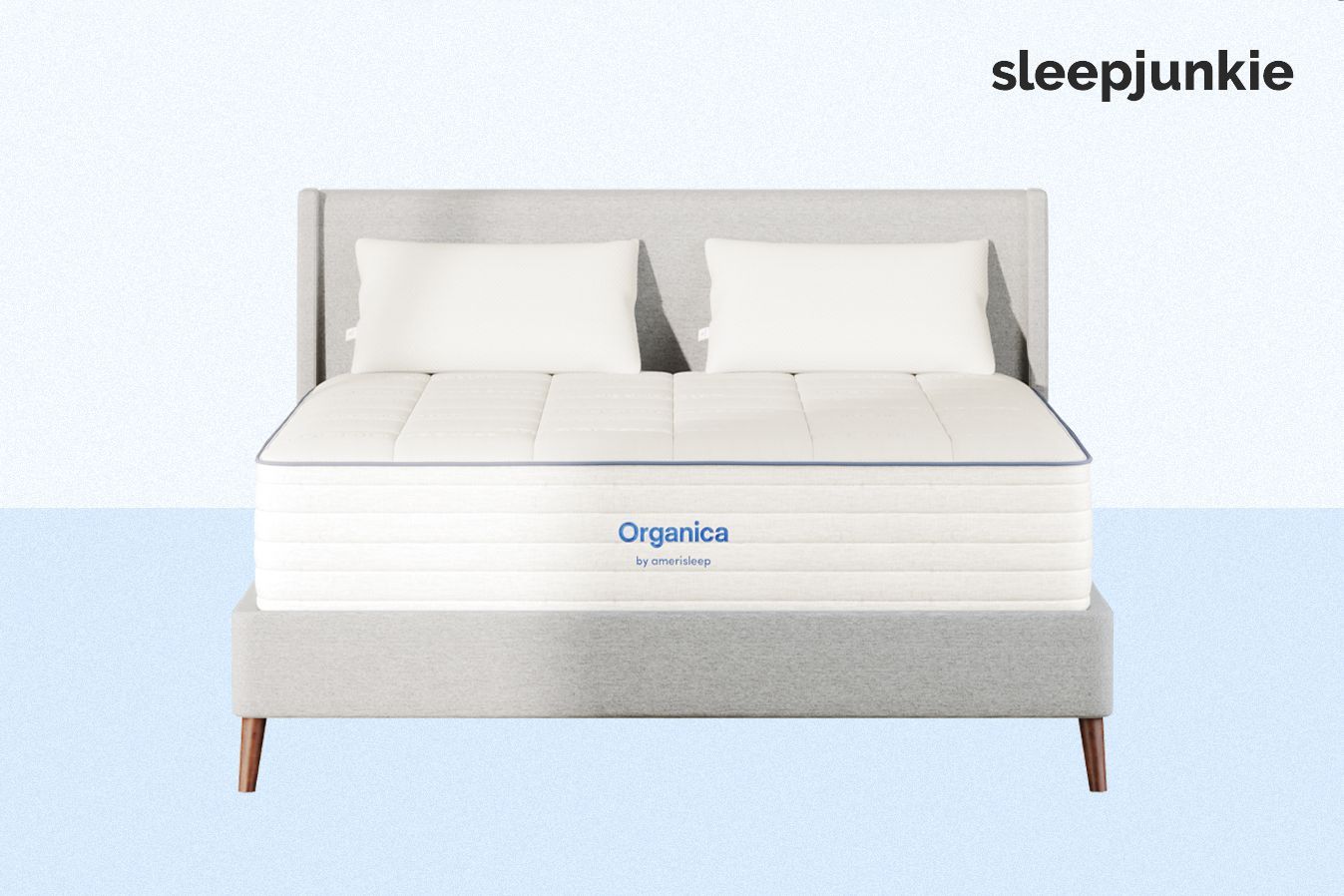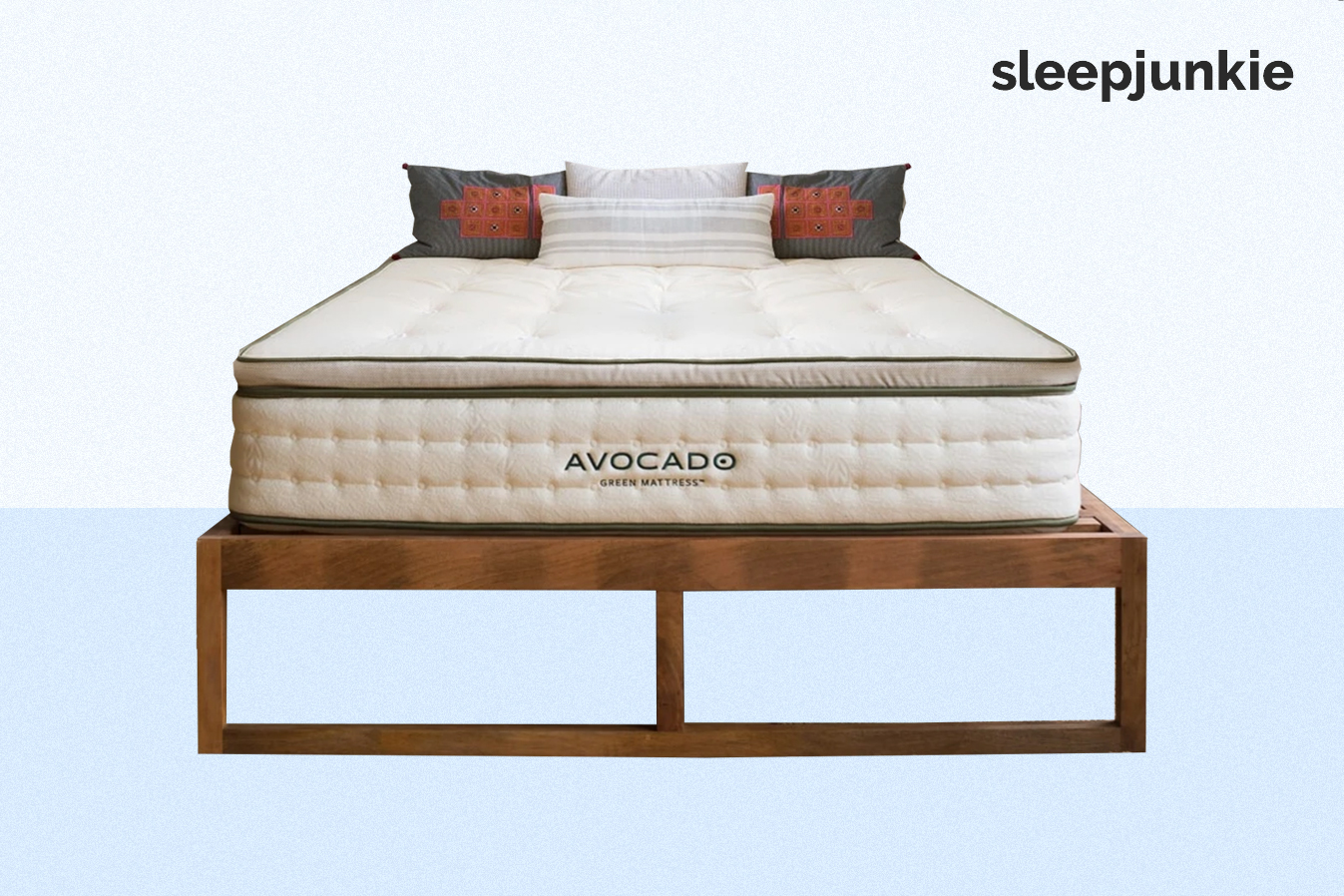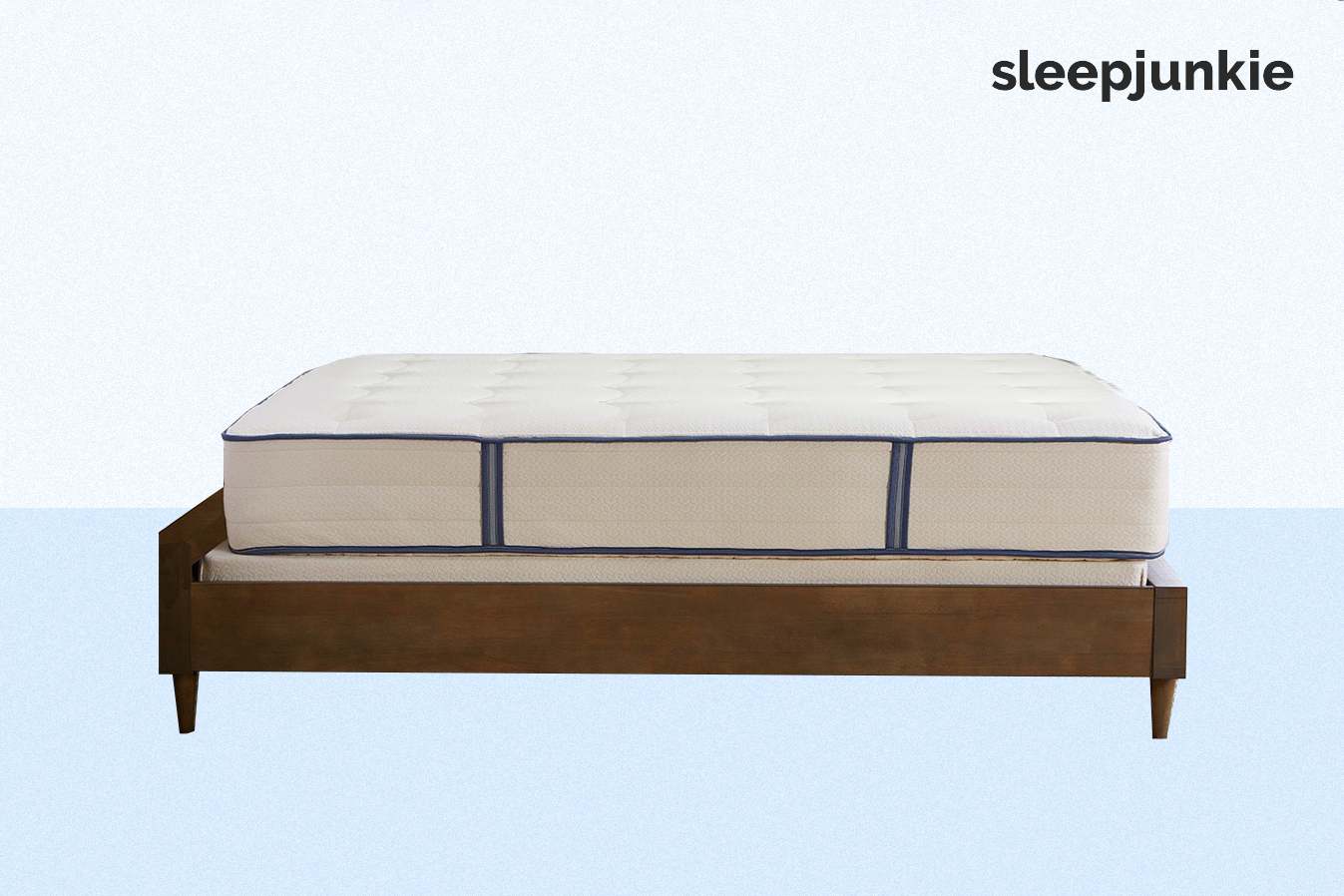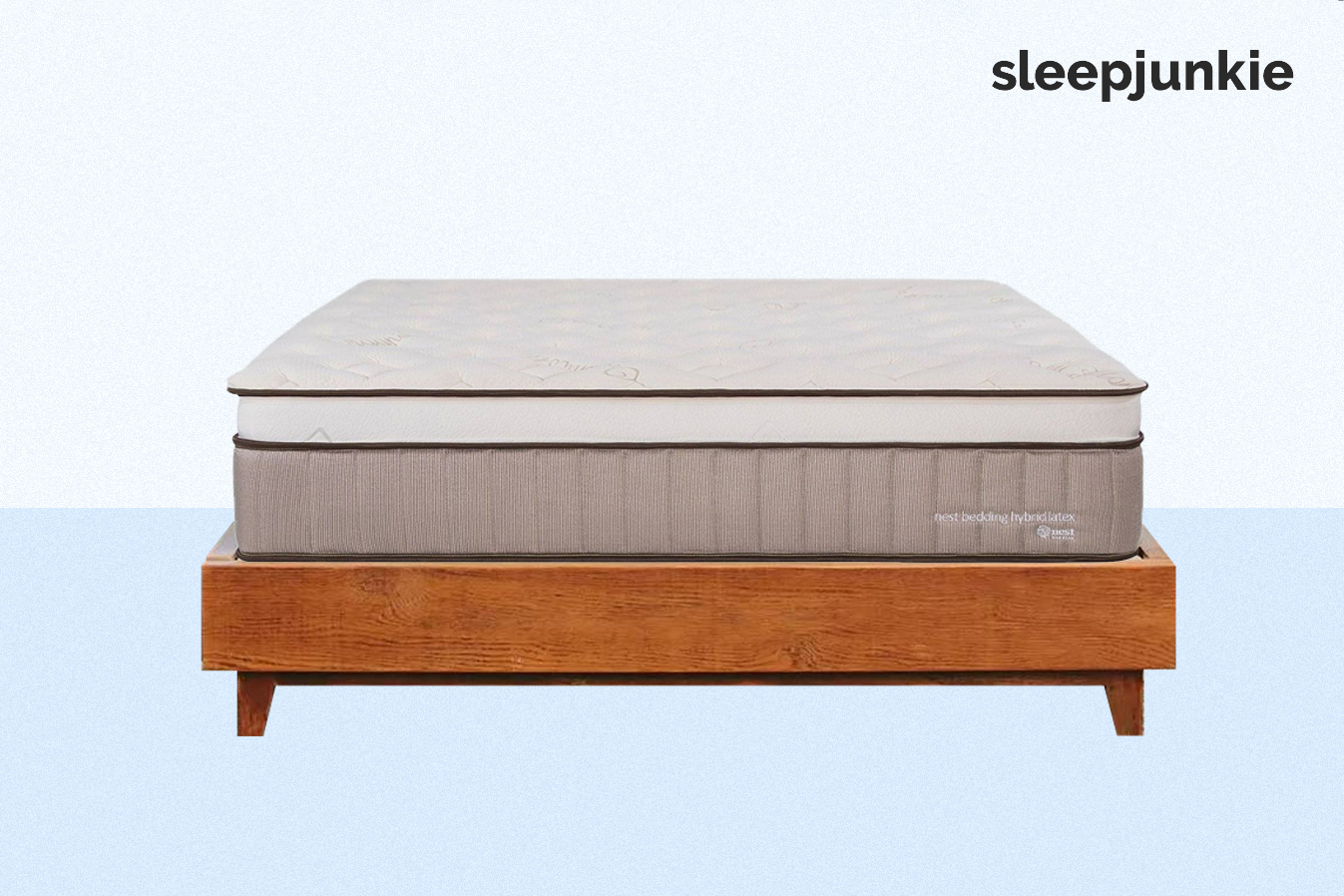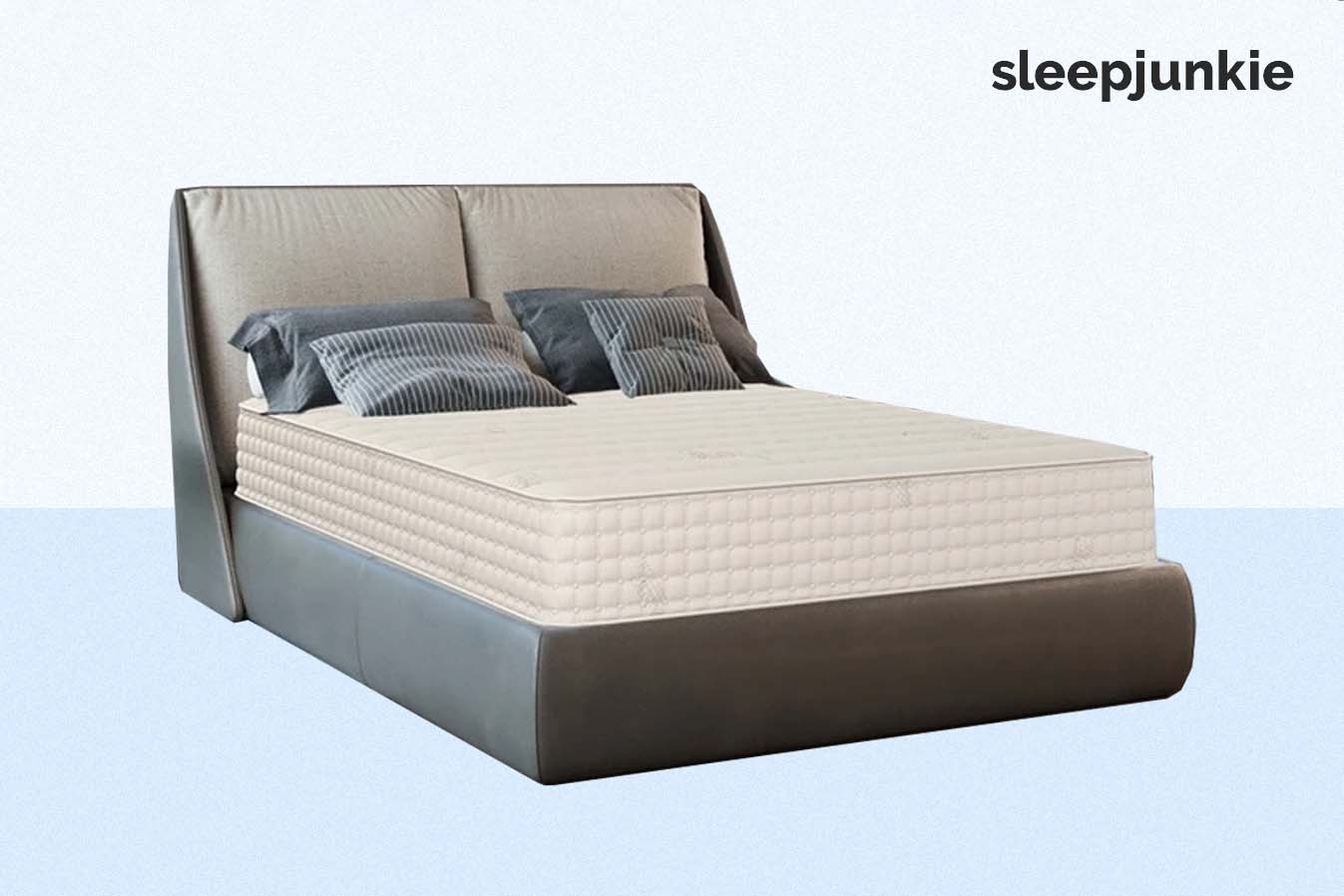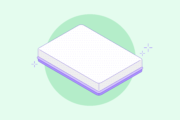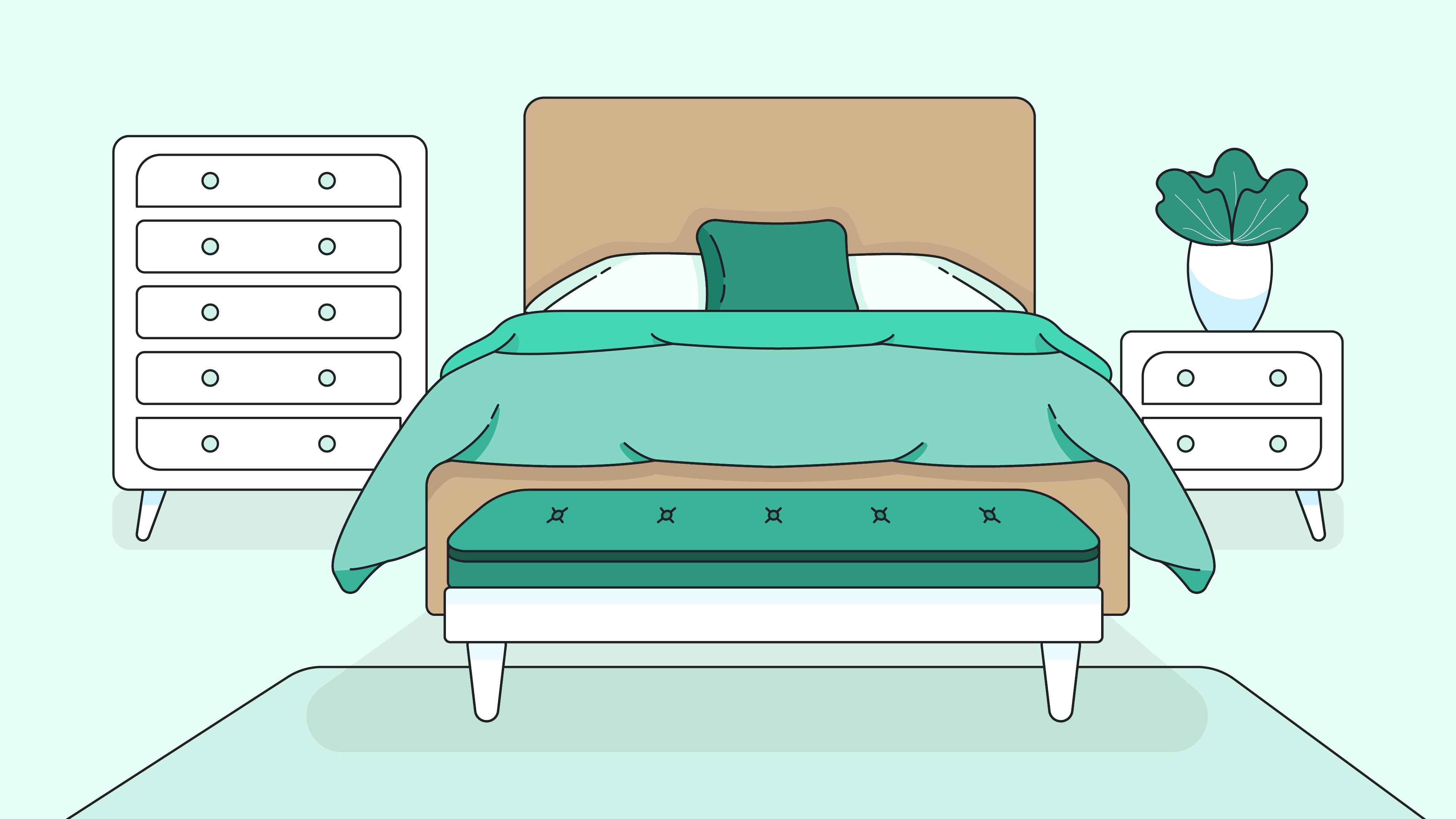
Best Latex Mattress of 2024

Latex mattresses are highly sought-after by “green” shoppers looking for the best eco-friendly mattress; however, all-natural latex mattresses offer a variety of sleep-promoting benefits most anybody can benefit from (even if you aren’t a “green” shopper). These mattresses are contouring, cooling, and comfortable for the majority of sleepers, making them excellent for those with aches and pains, or even those who tend to sleep hot.
In this post, we discuss the best latex mattresses on the market today, the pros and cons of these beds, and offer pointers on choosing the right one for your needs.
Best Latex Mattresses
The Amerisleep Organica is a latex hybrid with Talalay latex on top of pocketed coils and a Dunlop foam base.
The mattress’s cover is breathable cotton, the yarns certified by the Global Organic Textile Standard (GOTS). Cotton is one of the best fabrics when it comes to promoting a soft and cool sleeping surface. The organic cotton cover has a reduced carbon footprint, compared to non-organic cotton fabric.
The first layer is an inch of New Zealand Joma wool, a temperature-neutral material that feels cool when it’s hot and warm when its cold. Wool also wicks moistures away from a sleeper’s body, ensuring they don’t wake up sweaty and sticky. Lastly, the plush feel of wool cushions a sleeper’s body for gentle pressure relief.
The second layer is 3 inches of Talalay latex, a buoyant, breathable material that acts as the mattress’s second comfort layer. Talalay latex responds well to a person’s movements and resists compression, providing adaptable and durable comfort. The mattress’s latex is certified by three organizations:
The third layer is 8 inches of pocketed coils that act as the mattress’s support core. Edge support at the sides of the mattress make it easier to slip in and out of bed.
The last layer is an inch of Dunlop latex, a sturdy material that structures the coils to increase the mattress’s overall longevity.
Like every other Amerisleep mattress, the Organica comes with free shipping and contactless delivery, a 100-night sleep trial, and a 20-year warranty. If the feel isn’t what you expected after 30 nights, Amerisleep will work with you to return the mattress.
AMERISLEEP ORGANICA
- Medium feel suitable for side, back, and combination sleepers
- Numerous certifications prove the high quality of the mattress's materials
- Conforming latex foam relieves pressure points
The Avocado Green Mattress is a hybrid bed with Dunlop latex and a pocketed coil system. Overall, it’s 11 inches tall, meaning it’s average height and should fit nicely within most bed frames.
Avocado prides themselves on their eco-friendly business model and healthy beds. They’re GREENGUARD Gold Certified, which means their beds are low in VOCs and safe to use in healthcare facilities.
They also use wool and cotton in their beds, both of which are GOTS organic certified. The wool used in this mattress is OEKO-TEX Standard 100 Certified, too. These certifications ensure Avocado is using some of the highest-quality and healthiest materials in their beds.
Additionally, they state on their website their beds are completely free from blended and synthetic latexes.
The cover of the Avocado Green mattress is their certified organic cotton and wool; this blend feels cozy to the touch. Wool is naturally moisture-wicking, so this cover should move heat away from you while you sleep to keep you cool.
The first layer of their mattress is two inches of all-natural Dunlop latex. When you lay down on the Avocado mattress, this layer of latex should contour to your body while offering a more springy feel. As we mentioned earlier, latex is very breathable— Avocado expands upon this by pin-holing their latex, increasing the airflow throughout the mattress.
Immediately below the latex layer is the layer of pocketed coils broken into three targeted zones; this material is called Quantum Edge® Elite Combi-Zone®. These zoned pocketed coils provide enhanced targeted support and pressure relief in your shoulders, hips, and back. They also offer a bit of bounce, which reinforces the latex layer above and gives the bed an overall bouncy and responsive feel.
The Avocado Green Mattress is available with or without a pillow top. If you choose to add the pillowtop, it adds two inches to the height of the mattress. Overall, they rate their mattress as being medium-firm. Typically when looking for the best mattress for back or stomach sleepers, medium-firm mattresses are comfortable.
After you buy the Avocado and it’s delivered free to your doorstep, you have a full year to try it out and decide if it’s the best for you. If you do choose to keep it, it’s backed by an extensive 25-year warranty. All in all, a Queen Avocado bed costs you $1,799.00, or $2,199 if you want to add a pillow-top.
AVOCADO GREEN MATTRESS
- Available with optional pillow top for added comfort
- Contains zoned support to promote healthy spinal alignment
- Cotton and wool works with latex for greater cushion
Like the Avocado, the Natural Escape bed by My Green Mattress is a hybrid combining both latex layers and innerspring coils. The top layer of the mattress is three inches of Dunlop latex followed by a 5-zone pocketed coil system. It’s available in all standard mattress sizes and has a medium-firm feel.
We recommend the Natural Escape to side, back, and stomach sleepers alike as it’s supportive but contouring; however, some side sleepers may prefer a softer mattress to better cradle the shoulders and hips. This bed’s 5-zoned pocketed coil system offers dynamic support to alleviate pressure points and maintain healthy spinal alignment, so you should never worry about waking up with aches and pains.
The Natural Escape mattress is perfect for those seeking an organic bed, as it features GOLS certified Dunlop latex, GOTS-certified organic cotton, and GOTS-certified organic wool. Plus, every Natural Escape mattress comes with a 120-night sleep trial and a 20-year warranty. My Green Mattress does recommend rotating (not flipping) your Natural Escape mattress every three months to prevent sagging and extend the bed’s lifespan.
NATURAL ESCAPE
- Budget-friendly recommendation
- Available in a medium-firm feel that suits different styles
- Multiple organic materials
Nest Bedding prides itself on offering one of the purest, cleanest, most organic latex mattresses you can buy— the Owl, formerly known as the Certified Organic Hybrid Latex. Nest partners with OMI’s Eco-Factory™ to ensure their beds meet the highest of standards set by organic certifications.
Nest’s Owl features layers of all-natural, GOLS-certified Dunlop latex sourced from rubber trees and sanitized for cleanliness on top of a durable pocketed coil innerspring system. They use GOTS-certified organic wool and GOTS-certified organic cotton in the cover of their mattress.
Plus, they use all-natural fire retardants instead of chemical-based fire barriers. Nest even states on their website that the professionals assembling each of their Owl mattresses aren’t allowed to wear scented deodorants or perfumes, ensuring you’re getting the freshest mattress possible.
We are fans of this mattress because it has a zippable cover that allows you to uncover the bed and rearrange the latex layers for customizable firmness. Nest’s Owl is great for sleepers of all body types and sleep styles.
Every Nest Owl mattress comes with a lifetime warranty and a 365-night sleep trial.
NEST OWL
- Meets highest standards set by organic certifications
- Latex hybrid mattress with customizable layers
- Year-long sleep trial for thorough at-home testing
The PlushBeds Botanical Bliss mattress is an all-latex mattress featuring layers of Dunlop latex foam, organic New Zealand wool, and an organic cotton cover. We like this mattress because it allows for customizable firmness. The mattress is available in 9,10, or 12-inch thickness options.
Each bed comes with 3 latex layers (besides the 12-inch model, as it features four) that can be rearranged to meet your comfort needs. Each layer is different in firmness, so they can be re-ordered to have softer or firmer layers on top. On their website, they offer an instructional guide on how to rearrange your layers to find your most comfortable set-up.
PlushBeds uses GOLS-certified Dunlop latex in each of their beds to give their mattress a bouncy, yet firm feel. Plus, their latex is free of chemicals, pesticides, fillers, dyes, or carcinogenic adhesives— so it’s safe and clean.
The cover of this mattress is 1 inch thick featuring both New Zealand wool and organic cotton. Wool assists in temperature regulation as it wicks away body heat and prevents heat retention. Cotton also helps keep you cool due to its breathability.
We recommend this mattress to all sleepers because it can be customized to meet personal needs. Every Botanical Bliss mattress comes with a 25-year warranty and a 100-night sleep trial.
PLUSHBED BOTANICAL BLISS
- Available in different thickness options
- All-latex mattress with adjustable firmness
- Lengthy 25-year warranty for protection
Benefits of Latex Beds
All-natural latex is sourced from rubber trees, so it’s more eco-friendly than other materials. Because this latex is sourced from trees and does not require harsh chemicals to manufacture, there’s a smaller chance of these beds off-gassing. They’re also resistant to mold and dust mites while being naturally allergen-free. If you are looking for a “green” or hypoallergenic mattress, natural latex is certainly the way to go.
Another benefit of latex mattresses is how have a “feel” of their own, distinctly different from a bed with a coil system or one made with foam. When you lay down on a latex bed, you’ll feel slight sinking at first as this layer contours to your body but then should begin to feel more “lifted” support. Where traditional memory foam offers a more cradling, “in the bed” feel— latex suspends your body and prevents it from sinking very far.
Latex beds are considered some of the best mattresses for back pain because they’re exceptional at alleviating muscle aches, joint pain, and reinforcing the natural curvature of your body. Because latex is responsive and doesn’t allow you to sink too far, it helps promote your spine’s alignment. Heavier parts of your body, like your hips and shoulders, sink further into the latex than lighter areas of your body, which supports the spine naturally.
Lastly, latex is an ultra-breathable material and receives the lowest percentage of heat complaints when compared to other beds. If you’re prone to sleeping hot, latex can help keep you cool at night. It’s also great for couples because it isolates motion well.
Cons of Using Latex
Though latex beds come with a slew of perks, they do have their downfalls, too. First and foremost, their price. All-natural latex beds are some of the more expensive mattresses you can buy. The high cost comes from natural materials and enhanced strength. It’s important to note, latex is a highly durable material and the average latex mattress has a lifespan of 15 years. Though they may have a hefty price tag, they’re built to ensure your investment will be worthwhile. Plus, there are a handful of mattress sales throughout the year— waiting to buy when the bed is at a discounted price could save you a pretty penny.
Another downfall to owning a latex bed is the maintenance that comes with them. Not all latex brands, but a handful of them, recommend periodically flipping or turning your mattress to prevent indentations or premature sagging. Latex is one of the heaviest mattress materials out there, so they aren’t necessarily the easiest to maneuver. If you don’t share your mattress with another person, or feel you’ll have the available help to assist with moving and turning your mattress every so often, this could create an issue for you.
Even though latex mattresses have many redeeming qualities, they’re not as commonly found as memory foam, or even hybrid, mattresses. Still, there are enough on the market to complicate your decision-making process. We recommend consulting our latex mattress buying guide as you shop.
Different Types of Latex
There are three main types of latex: Talalay, Dunlop, and Synthetic. The Editors at Sleep Junkie do not recommend choosing a synthetic latex blend. That said, we’ll still touch upon them so you are well-educated on all of your options.
Talalay and Dunlop latex are not drastically different from one another, the main distinction between the two types is how they’re manufactured. In regards to feel, Dunlop feels springier than Talalay, which is more bouncy. Below, we’ll explain each type.
Dunlop Latex
The Dunlop process is a more efficient way to manufacture latex when compared to its alternative, Talalay. When natural latex is derived from rubber trees it is in liquid form. The Dunlop begins with pouring said liquid latex into a mold. The mold is then sealed up and placed onto a conveyor belt and placed in a vulcanization oven. After the mold has been vulcanized, the latex is removed and thoroughly washed. After the latex has been washed, it’s dried at a high temperature to ensure no moisture is still in the material.
Talalay Latex
Talalay latex is made in a more extensive process, expanding upon the Dunlop method. Similar to Dunlop, this process starts with liquid latex poured into a mold. However, during the Talalay process, liquid latex is only poured into the mold halfway. Once the mold has been partially filled with liquid latex, they use a vacuum to expand the latex until the mold is completely filled. Then, when fully expanded, the mold is frozen. During this freezing process, carbon dioxide is pushed through the latex, causing it to gel. Afterward, the latex is vulcanized, washed, and thoroughly dried.
Synthetic Latex
Synthetic latex is created in a lab and made with a mixture of chemicals. Because this material is made almost exclusively with chemicals, it’s not as healthy to sleep on as all-natural latex beds. There’s also a much higher chance of experiencing bothersome odors with synthetic latex, as chemicals are what create unpleasant off-gassing.
It’s important to note, some latex bedding brands use a combination of natural and synthetic latex, and even some “all-natural” latex beds contain up to $300 synthetic latex. Before you buy, make sure to read the fine print and ask questions about the materials of the layers inside. Again, we do not recommend choosing a synthetic latex bed because of the harsh chemicals used to manufacture the material.
Mattress Types
Not sure which type of mattress is best for you? In this section, we compare different mattress types to help you find your best fit.
Latex vs. Memory Foam
Latex and memory foam mattresses are both considered all-foam beds; however, latex mattresses feature latex layers just as memory foam mattresses include memory foam layers. All-foam beds are ideal for couples, as they minimize motion transfer, noise, and help you get undisturbed sleep. These mattresses are also great for sleepers with aches and pains because they’re more contouring and pressure-relieving than most beds with springs.
The biggest difference between memory foam and latex mattresses is how they feel. Though they’re both all-foam beds, they have distinctly different feels. Memory foam is cradling, and sometimes described as feeling like a “big hug.” One of the biggest complaints with memory foam mattresses is their tendency to trap heat (though more modern memory foam mattresses are now built with cooling technologies for temperature regulation).
Latex mattresses, on the other hand, are more lifting than cradling. These keep you sleeping “on top” of the mattress and don’t allow for much sinkage. Plus, they’re naturally cooling and tend to dissipate heat better than other all-foam mattresses (memory foam or poly-foam beds).
For those seeking an organic or cooling mattress, we suggest choosing a latex bed. It’s also one of the best materials when considering non memory foam mattresses. However, if you’re looking for a bed for pain relief or something that offers a more “cloud-like” feel, choose memory foam.
Latex vs. Hybrid
Hybrid mattresses differ from latex beds in the fact that they contain a coil spring system. By definition, hybrid mattresses are mattresses that contain the materials of two (or more) different mattress types (memory foam and innerspring coils; latex and innerspring coils; memory foam, latex, and innerspring coils; memory foam and latex). While most hybrids contain memory foam and innerspring coils, you can find latex hybrids as well (such as the Avocado featured in our post).
We recommend hybrid mattresses to sleepers who want or need the cushioning comfort of foam layers but still prefer a bouncier mattress.
Latex vs. Innerspring
Latex mattresses are far different from innersprings, as innerspring mattresses contain coil cores and pillow tops, and latex mattresses feature latex layers. Though innerspring mattresses were very popular for years, they’re slowly becoming the least sought-after bed due to the fact that they break down quickly and don’t contain cushioning foam layers for comfort.
We recommend innersprings to those looking for a budget-friendly bed or those seeking a mattress to use for a short period, as these beds typically cost a few hundred dollars and start sagging after 5 or 6 years. However, if you have aches, pains, or are looking to make an investment in better sleep, choose a latex mattress, as they’re far more durable, contouring, and tend to have a lifespan of 15 years.
Factors to Consider When Choosing the Best Latex Mattress
There is no one-size-fits-all latex mattress on the market, to find your best mattress consider your sleep style, preference for firmness, and any recurring aches and pains you may wake up with — these factors will steer you towards the most comfortable mattress for your needs.
Also, don’t forget to consider warranty policies and sleep trials, too, as these help you decipher whether or not your potential new mattress is a good value.
Sleeping Positions and Firmness Levels
While personal preference does have some influence when deciding how firm your mattress should be, the way you sleep is a much better indicator of your new mattress’s ideal firmness.
Side Sleepers
Side sleeping is the most common of all sleeping positions. Sleeping on your side can help eliminate snoring and symptoms of sleep apnea, but sleeping in this position can cause pressure points under the shoulders and hips — that’s why the best mattresses for side sleepers are medium in firmness, as they’re soft enough to relieve pressure under those joints but still firm enough to maintain healthy spinal alignment.
Side sleepers can benefit from latex mattresses because they’re naturally contouring but don’t cradle you as much as memory foam mattresses do, so they’re typically better at keeping you lifted in the mattress and preventing misalignment.
Stomach Sleepers
Stomach sleeping is the unhealthiest due to the strain it puts on your lower back, spine, and abdomen. We advise against stomach sleeping because it can lead to long-term lower back pain, and considering how prevalent back pain already is, we shouldn’t be putting any unnecessary stress on our spines.
We recommend stomach sleepers switch to side or back sleeping if possible. That said, the best mattresses for stomach sleepers are firm to prevent midsection sinkage and lower back strain. Latex mattresses are one of the better options for stomach sleepers since they have more “lifting” support than other mattresses.
Back Sleepers
While stomach sleepers are best suited on firm beds and side sleepers should stick to medium mattresses, the best mattresses for back sleepers can range between medium-firm, medium, and medium-soft.
Back sleepers are at an advantage when it comes to spine health because they lay in a neutral position, allowing the spine to rest in proper alignment. However, it’s important back sleepers find a mattress supportive enough to prevent the hips from sinking down into the mattress, as this would throw you out of alignment and lead to aches and pains.
For back sleepers, choosing the best mattress firmness depends on body weight. Petite sleepers will find most mattresses feel firm, so they’ll likely prefer medium or soft mattresses. On the other hand, plus-size sleepers will sink straight through too-soft mattresses, so they’re usually most comfortable on medium-firm beds. Of course, consider your preference for firmness as well; if you’re a petite sleeper but like the feel of a firm bed, you can certainly get good sleep on a medium or medium-firm mattress.
Sleep Trial
When buying a new bed, it’s always best to look for one with a sleep trial. While trying a mattress in-store can be helpful in choosing your next bed, it’s not nearly as beneficial as sleeping on your potential new mattress in your own home for a few weeks.
Sleep trials are usually at least 90 days, giving you a few months to sleep on your new bed at home and decide if you like it. Most brands offer risk-free sleep trials, meaning they’ll refund you in full should you decide against keeping it. However, we always recommend reading the fine print of the sleep trial to make sure there aren’t any hidden fees.
Return Policies
If your bed doesn’t come with a sleep trial, it may come with a return policy. While return policies don’t offer you months to try your new bed, they do typically span 30-nights and allow you some time on your new mattress. Return policies ultimately prevent you from being stuck with a mattress you find uncomfortable or are unhappy with, as we all know it can be difficult to choose a mattress that’s best for you after a 15-minute mattress test drive in the showroom.
Warranty
Buying a mattress is an investment towards better sleep, and mattress warranties help protect that investment to ensure you get the most for your money. Typically, mattress warranties span 10 years; however, some mattress brands offer 20-year or even lifetime warranties. We recommend reading the fine print of the warranty agreement before purchasing so you’re aware of what’s covered and what fees you’d be responsible for in the event of a warranty claim.
Good mattress warranties usually cover sagging as little as .75 inches; warranties that don’t kick in until your bed has sagged an inch or 1.5 inches are okay, but not preferred— as an inch-deep sag in your mattress can make sleep very uncomfortable. Look for warranties that kick in when the sag is less than an inch deep, as these will cover you before your mattress becomes too uncomfortable.
Frequently Asked Questions
What’s the best mattress foundation for a latex mattress?
The best mattress foundations for latex beds are solid and flat. These beds are some of the heaviest mattress types, so they need a sturdy foundation to prevent sagging and damage. Latex mattresses can work on slatted mattress foundations, too, but we recommend the slats are no more than 2 inches apart.
Apart from standard mattress foundations and bed frames, latex mattresses pair well with adjustable bed frames. Adjustable bed frames have a solid, flat surface for your mattress to rest on, but they adjust the angle of your head and feet, allowing you to find the most comfortable position for sleep.
Why is latex the best mattress material?
Whether or not latex is the best mattress material is really a matter of personal preference. Yes, latex offers a handful of sleep-enhancing benefits, but some people like memory foam and others just prefer beds with springs.
Latex is loved by many for its natural cooling, hypoallergenic, and supportive properties. Plus, latex is very durable, and some latex mattresses can last up to 20 years (we suggest replacing them after 10 for hygenic reasons, though).
Is a latex mattress worth it?
If latex appeals to your preferences and you choose a latex mattress with a comfortable firmness, one of these mattresses is certainly worth the investment. Considering how long these mattresses last, you won’t have to worry about having to replace your bed anytime soon.
Can bed bugs live in latex mattresses?
It’s hard for bed bugs to thrive in any foam bed (memory foam, latex foam, poly-foam) because foam is so dense. However, bed bugs can still infest these mattresses, as they burrow into your bed frame and surrounding bedroom furniture. Bed bugs may be a little less likely to ruin foam beds than innersprings, but they’re still something to be cautious of and keep in mind.
How thick should a latex mattress be?
Latex mattresses should be no thinner than 10 inches tall, unless you’re buying a latex mattress for a child, and then we suggest 6 and 8-inch mattresses. Most high-quality mattresses are between 10 and 14 inches thick, a thinner bed is likely to break down sooner.
Did You Find the Best Latex Mattress?
We hope this article has helped you decide whether or not a latex mattress is the best mattress for you. During your search for a new mattress, we encourage you to read other mattress reviews to get honest feedback about different brands and beds. Plus, shop in confidence knowing some of the best brands offer generous sleep-trials.
